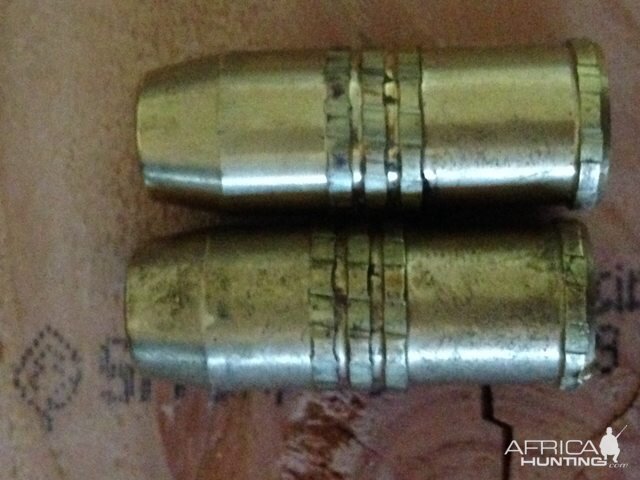And once again.................
There are 8 Absolute Known Factors for Solid Penetration and are as follows in Order of Importance.....
#1 Meplat Percentage of Caliber
Meplats that attain 65% Meplat of Caliber are terminally stable.... Above 70% Meplat bullets remain stable, however depth of penetration begins to decrease with every step up in meplat size. 70% Meplat or larger does increase trauma to, and destruction of tissue. 70% Meplats start to get difficult to feed, even in Winchester M70s...... From 65% Meplat to 68% Meplat is OPTIMUM for Stability, destruction of tissues, and feed and function in most quality rifles..........
#2 Nose Profile
There are many and varied Nose Profiles of solids on the market today, from the angled Nose Profiles of CEB and North Fork, to the straight nose profile of the older North Forks and GSC, the Barnes/Hornady Profiles (like a RN cut off at the top) to many more... Not all of these are created equal, and some are better performers than others. In recent tests in comparison between the old North Fork Profiles and the Newer North Fork Profiles I was getting 20% deeper penetration with the Newer North Forks than the older, with the same bullet, just difference in Nose Profile is all.... John at North Fork agrees, and in their work there they were getting more along the lines of 25% deeper penetration. One major thing that I noticed here, the stability at the end of penetration was 100% better. In most all tests here the last 2 inches of penetration of the old style North Forks would be unstable. Now this is and was of no consequence at the very end of penetration. The depth of penetration of these older nose profile bullets was always so deep that it had long accomplished its mission before loss of stability right at the very end. This new NOSE PROFILE of North Forks remains DEAD STRAIGHT to the very last of penetration, and always found NOSE FORWARD........
#3 Construction & Material
Construction of a solid is a major part of its ability to penetrate. To deny this is foolish to say the least. Some of our solids out there, lead core, are very very weak in construction and absolutely do not have the ability to bust through heavy bone and reach their intended targets. I have seen and have in hand failures of these bullets from the field..... A shame as well, as some of these bullets are promoted as Dangerous Game Solids, and some of them flatten out like pancakes when hitting heavy dense material. Some FMJ Have steel inserts, while this solves a problem in one area, it creates problems in other areas.... Brass is harder than Copper... No surprise there, but I have busted elephant heads with both copper and brass, and never had one distort, but, these solids were of a very STRONG NOSE PROFILE as well........ So you see, combinations of different factors work together to strengthen or weaken other factors..... A good strong Nose Profile, can overcome some material deficiencies and in the case of copper solids this is extremely important.
#4 Nose Projection
Nose Projection above the top bands was the last factor discovered. There may be more factors, but currently they remain undiscovered at this point in time.... We found that nose projection above the top of the bands of current CNC monolithic bullets is very important to depth of penetration. Some bullets designed to work through lever actin riflers require a SHORT NOSE PROJECTION in front of the bands so that they can be loaded deep enough to work through the actions of these guns... Nose Projection of these same bullets for bolt guns, single shots, and double rifles are longer, from .600 to .700 in front of the top band. The LONGER NOSE PROJECTION solids will penetrate on average 25% deeper than the shorter nose projection. Now, these bullets already have all the other required factors for stability, nose profile, construction and radius, so it is ONLY DEPTH Of penetration that is effected with properly designed bullets.
#5 Radius Edge of Meplat
We found that the radius edge of the meplat made a difference, small, but a difference none the less. A nicely radius edge penetrates about 5% deeper, and has more stability at the end than a sharp edged radius.... No more to go into here, thats it.......
All the Above Factors Deal with Bullet Design........
#6 Velocity
Velocity is a factor, but it also goes hand in hand with Nose Profile and Construction/Material. If we assume that the Meplat is optimum, the nose projection is optimum, and the bullet has a nice radius then velocity becomes a factor in combination with nose profile and construction/materials. Different Nose Profiles react differently with velocity. Some nose profiles at very low velocity cannot maintain stability, but this would be in the extreme, and other factors may come into play with some of this. In essence with some Nose Profiles, added velocity will equate to added depth of penetration, and of course trauma and destruction of tissue. Some nose profiles react better than others, but if properly designed, then all will get some gain from added velocity, UNTIL you reach the point that you get distortion of the meplat by TOO MUCH VELOCITY. Once you begin to distort that meplat, then all sorts of strange things begin to occur. One is depth of penetration will decrease, stability will decrease as well....... Normally you will only get this at extreme velocities at 2700-2800 fps or more, which in our big bore rifles is somewhat extreme.......... Lead core bullets will be effected in a serious manner at extreme velocities, followed by copper, and then brass........ Nose Profile and Construction & Material are very important for Factor #6.........
#7 Barrel Twist Rate
Barrel twist rate really only becomes a factor when Factor #1 is DEFICIENT....... If the meplat of caliber is undersized, less than 65%, then faster twist rates WILL INCREASE the depth of penetration by increasing the stability of terminal penetration. A 65% Meplat of Caliber can stabilize in slower twist rates of 1:18, or even slower...... I have seen 65% Meplat of Caliber stabilize with ZERO TWIST....... I have seen 50% Meplat of Caliber stability increase with faster twist rates, and have documentation to prove it, several times...... If you are using a properly designed Solid, then twist rate becomes less important, and more important if you are not using a proper designed solid. Fast Twist Rates can also increase stability of even RN Solids of decent design, hardly anything can increase stability of a more pointy RN FMJ.......
#8 Sectional Density
Sectional Density will ONLY BE A FACTOR with two bullets that are exactly the same in every other Factor or aspect. Factors #1 and #2 far outweigh Sectional Density in the terminal performance of Solids. We can take a properly designed 458 caliber 325 gr Solid and far out penetrate in depth and stability a poorly designed 550 gr 458 caliber bullet....... My son recently shot a medium sized elephant at 10 yards, perfectly executed side brain shot, with a 350 gr .474 caliber properly designed solid at 2200 fps. This bullet exited the head on the far side and still may be going for all I know. A 350 gr .474 caliber bullet has a sectional density of .223, and I personally would choose this little 350 gr bullet over the Woodleigh 500 gr RN FMJ at .4725 (ones I have here) any and every day for any mission............
These are undeniable facts, and can be proven over and over and over again in all test work, and these factors have been exercised in the field and have proven themselves in the field, many many times over...... These are the 8 Known Factors of Terminal Penetration of Solid Bullets.................



